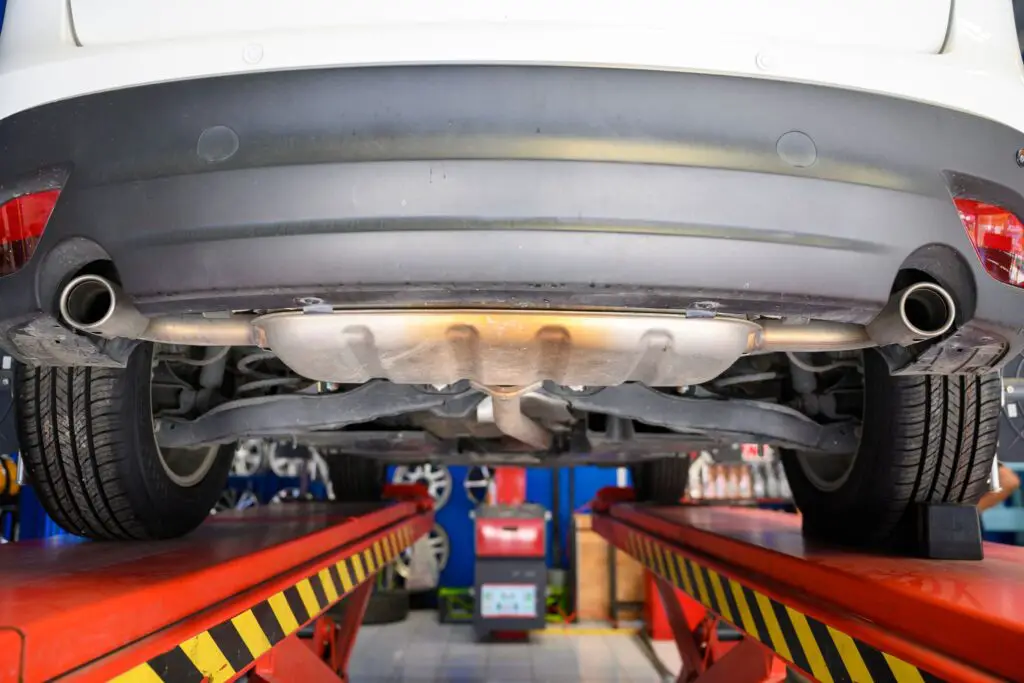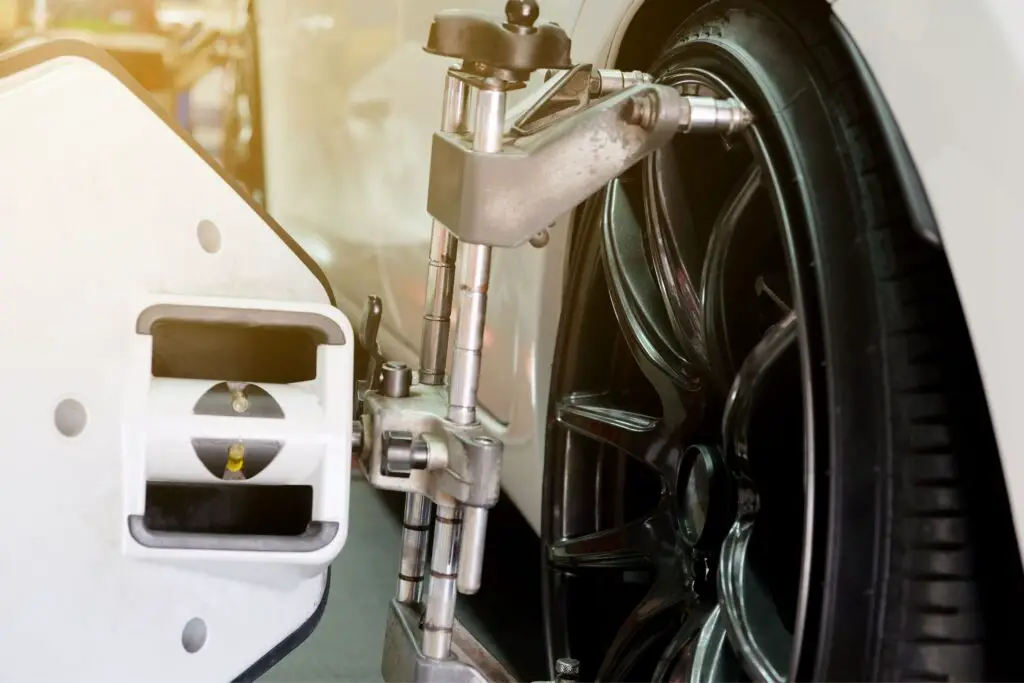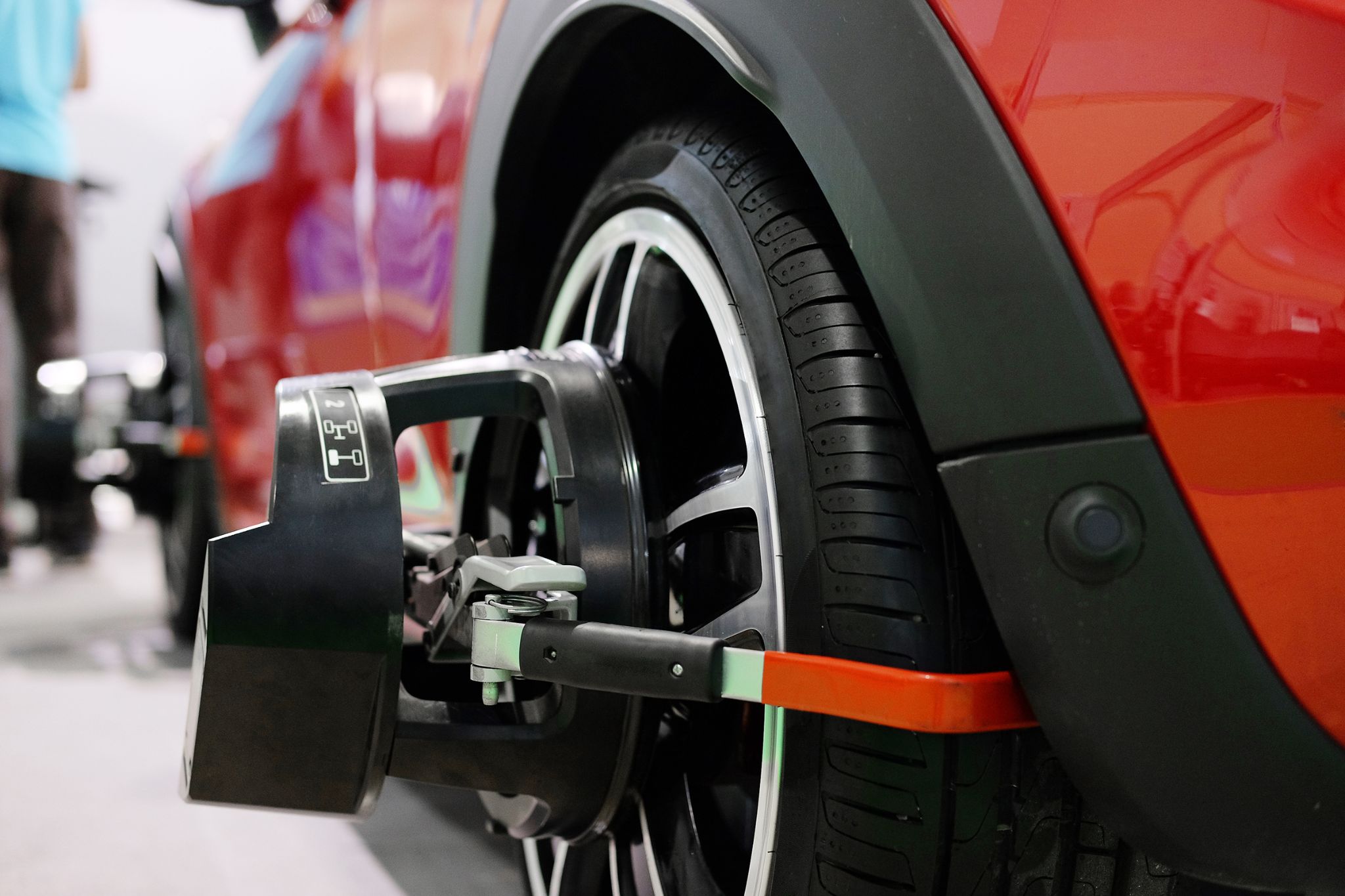Do you feel your Mazda’s wheels wobbling? Is your car not running as smoothly as it used to? Don’t worry, wheel alignment is the answer! Let’s look at how to properly align Mazda’s wheels to get your car running like new again.
Despite being often overlooked, maintaining proper wheel alignment is essential for the performance and safety of your Mazda vehicle. A well-aligned set of wheels can greatly improve handling, fuel efficiency, and tire longevity. It ensures that all four wheels are parallel to each other and perpendicular to the road surface.
When your Mazda’s wheel alignment is off, you may experience various issues such as uneven tire wear, unstable steering, and a drifting sensation while driving. These problems not only compromise your driving experience but also pose risks on the road. Therefore, it is crucial to understand the importance of regular wheel alignments for your Mazda.
One unique detail to note about Mazda wheel alignment is that it should be performed by certified technicians using advanced alignment equipment. This ensures precision and accuracy in adjusting the angles of the wheels according to Mazda’s specifications. Neglecting this important aspect or attempting DIY alignments can lead to incorrect adjustments and potential damage.
To maintain proper wheel alignment for your Mazda, follow these suggestions:
- Schedule regular inspections and alignments as recommended by Mazda’s maintenance schedule. This will help catch any misalignments early on and prevent further damage or excessive tire wear.
- Avoid potholes or rough road conditions whenever possible. These can throw off the alignment of your wheels and disrupt their balance.
Lastly, be mindful of how you drive. Avoid aggressive maneuvers that could put unnecessary stress on your suspension system and cause misalignment over time.
By adhering to these suggestions, you ensure that your Mazda maintains optimal wheel alignment. This not only contributes to a safer driving experience but also extends the lifespan of your tires, saves fuel costs, and preserves the overall performance integrity of your vehicle.
So remember, don’t overlook wheel alignment for your Mazda! Stay proactive in maintaining proper alignment through regular inspections and mindful driving habits.
Get your Mazda’s wheels aligned and avoid the awkwardness of driving straight into a pole, because hugging trees is so last season.
Mazda Wheel Alignment
Mazda Wheel Alignment is a crucial aspect of vehicle maintenance. It ensures that the wheels are properly positioned and aligned to maximize performance and safety on the road.
Below is a table highlighting the key factors involved in Mazda Wheel Alignment:
| Factor | Description |
|---|---|
| Toe Alignment | The angle at which the tires point inward or outward when viewed from above. Improper toe alignment can cause tire wear and affect handling. |
| Camber Alignment | The angle at which the wheels tilt inward or outward when viewed from the front. Incorrect camber alignment can result in uneven tire wear and affect stability. |
| Caster Alignment | The angle of the steering axis when viewed from the side. Proper caster alignment ensures straight-line stability and reduces steering effort. |
| Thrust Angle | The angle between the rear axle centerline and a line perpendicular to the vehicle’s centerline. Misalignment can cause poor tracking and drifting. |
In addition to these factors, Mazda wheel alignment also takes into consideration factors such as suspension components, tire pressure, and overall vehicle condition.
Pro Tip: Regularly checking and maintaining proper wheel alignment can significantly prolong tire life, improve fuel efficiency, and enhance driving comfort.
Is your Mazda veering off course like a bad stand-up comedian? It might be time for a wheel alignment before it starts testing out its own material.
Symptoms of a Mazda needing a wheel alignment
It is important to be aware of the symptoms that indicate a Mazda may need a wheel alignment. These signs can help identify any misalignment issues early on and prevent further damage to the vehicle.
- Uneven or rapid tire wear: One of the most common symptoms of a Mazda needing a wheel alignment is uneven or rapid tire wear. If you notice that your tires are wearing out more quickly on one side than the other, it could indicate misalignment.
- Pulling to one side: Another symptom is when your Mazda pulls to one side while driving. This can be an indication that the wheels are not aligned properly and may need adjustment.
- Steering wheel vibration: A steering wheel that vibrates while driving can also be a sign of misalignment. Vibrations can occur when the wheels aren’t properly aligned, causing uneven rotation and an unstable driving experience.
Addressing these symptoms promptly is essential in maintaining your Mazda’s performance and safety. Apart from these common signs, it’s always a good idea to have regular check-ups by a professional technician who can assess your vehicle’s alignment accurately.
A pro tip for maintaining proper alignment is to ensure that you have your Mazda’s wheels aligned every 6,000-8,000 miles or as recommended by your vehicle manufacturer. Regular alignments will help extend the lifespan of your tires and promote optimal handling and stability while driving.
From drifting dreams to precise parking, there’s a Mazda wheel alignment for every twist and turn on life’s crazy road.
Types of Mazda wheel alignments


There are different types of wheel alignments available for Mazda vehicles. These alignments ensure that the wheels are properly positioned, providing a smooth and safe driving experience.
Type Alignment Purpose:
- Front-end Alignment: Aligns the front wheels to ensure they are parallel and centered with each other. This type of alignment corrects issues such as uneven tire wear and drifting to one side.
- Four-wheel Alignment: This alignment involves aligning all four wheels of the vehicle to ensure they are parallel to each other and perpendicular to the road surface. It helps in maintaining stability and improves overall handling.
- Thrust Angle Alignment: In this type of alignment, the rear wheels are adjusted to align with the centerline of the vehicle. It corrects any misalignment caused by accidents or hitting curbs, preventing steering issues.
- Performance Alignment: This type of alignment is specifically designed for Mazda vehicles used in high-performance applications. It optimizes the suspension settings, ensuring precise handling and maximum performance on the track.
Apart from these standard types, Mazda also offers specialized alignments for specific models or situations, such as off-road or heavy-duty applications.
Pro Tip: Regularly checking and maintaining proper wheel alignment can extend your tire life, improve fuel efficiency, and enhance overall driving comfort and safety. Consider getting a wheel alignment at least once a year or whenever you notice any signs of misalignment, such as uneven tire wear or pulling to one side during driving.
Getting your Mazda’s wheels aligned can save you from ending up in a sticky situation – like trying to parallel park on a tightrope.
Mazda car alignment problems
Mazda vehicles are not immune to alignment problems, which can lead to various issues. One common problem is uneven tire wear, causing premature tire replacement.
This occurs when the wheels are not properly aligned and do not roll straight, leading to excessive friction on certain parts of the tires. Additionally, misaligned wheels can cause steering wheel vibration, difficulty in handling the vehicle, and even a decrease in fuel efficiency.
To overcome these Mazda car alignment problems, proper wheel alignment is crucial. Regularly scheduling an alignment check-up is a wise decision as it helps detect any misalignment promptly. This allows for adjustments to be made before further damage occurs.


Moreover, it is essential to pay attention to any signs indicating misalignment. Unusual tire wear patterns such as feathering or cupping might suggest that your wheels need realignment. Additionally, if you notice that your vehicle tends to pull to one side while driving or experience difficulty keeping the car straight, it may also indicate an alignment issue.
To rectify these problems and ensure smooth operation of your Mazda, here are some suggestions:
- Visit a professional: Seek assistance from an experienced technician who specializes in wheel alignments for Mazdas specifically. They have the expertise and necessary equipment to accurately align your wheels according to manufacturer specifications.
- Tire rotations: Regularly rotating your tires promotes even wear, extending their lifespan and reducing the risk of alignment issues caused by uneven tread wear.
- Avoid potholes and rough roads: Potholes and rough road surfaces can cause sudden jolts to your vehicle’s suspension system, which may result in wheel misalignment. Try to minimize exposure to such road conditions whenever possible.
- Be mindful of curb impacts: Hitting curbs or parking blocks can knock your wheels out of alignment. Always take care when parking or maneuvering your Mazda near curbs or other obstacles.
By following these suggestions, you can prevent or alleviate Mazda car alignment problems. Remember, maintaining proper wheel alignment not only ensures your safety but also enhances the overall performance and longevity of your Mazda vehicle.
Mazda wheel alignment: giving your car the precision it needs to navigate potholes like an obstacle course from hell.
What causes car alignment problems?
Car alignment problems can arise from a variety of factors. One of the main causes is hitting potholes or curbs, which can throw off the alignment settings of the wheels.
Another common culprit is general wear and tear over time, as components in the suspension system can become loose or worn down, affecting the alignment.
Additionally, accidents or collisions can significantly impact wheel alignment. It is important to address these issues promptly to avoid further damage and ensure optimal vehicle performance.
When it comes to car alignment problems, it’s crucial to be proactive in identifying and addressing any issues. Regular inspections and maintenance are key in preventing misalignments that can lead to uneven tire wear, decreased fuel efficiency, and compromised handling.
By maintaining proper wheel alignment, not only can you extend the lifespan of your tires but also enhance overall driving safety.
Furthermore, understanding the signs of misalignment is essential for prompt action. These signs may include a crooked steering wheel when driving straight, vibrations felt through the steering wheel or vehicle’s floorboard, or uneven tire wear patterns.
If you notice any of these indicators, it is advisable to schedule an appointment with a trusted mechanic who specializes in wheel alignments.
In addition to addressing immediate symptoms, neglecting regular wheel alignments may result in more severe consequences. Poor alignment places added stress on various parts of your vehicle such as suspension components and steering mechanisms.
Over time, this stress can accelerate wear and tear on these parts, leading to costly repairs that could have been avoided with timely alignments.
Don’t wait until noticeable problems arise; take action now to maintain proper wheel alignment! By proactively scheduling routine maintenance and staying vigilant for possible signs of misalignment, you’ll not only save money on future repairs but also enjoy a smoother and safer driving experience overall.
So why delay? Make an appointment today with a reputable automotive service center near you!
Mazda wheel alignment specs: because getting your wheels aligned is the only legal way to make your car bend it like Beckham.
Mazda wheel alignment specs


When it comes to Mazda wheel alignment, the specifications are crucial for ensuring optimum performance and safety. Aligning the wheels properly helps to maintain stability, improve handling, and increase tire longevity. Here are some key specifications to consider for Mazda wheel alignment:
| Front Wheel Alignment SpecsRear Wheel Alignment Specs | ||
|---|---|---|
| Camber | -1.0° ± 0.5° | -1.0° ± 0.5° |
| Caster | 5.3° ± 0.5° | N/A |
| Toe | 0.07° ± 0.03° | -0.07° ± 0.03° |
These values represent the ideal alignment settings for Mazda vehicles, allowing for minor variations within the specified ranges.
Apart from these standard specs, it is important to consider certain unique details specific to Mazda wheel alignment: – Check for any signs of uneven tire wear or abnormal handling, as they may indicate misalignment.
– Ensure that all suspension components are in good condition before aligning the wheels. – Pay attention to any special requirements or recommendations mentioned in your Mazda vehicle’s owner manual.
To achieve optimal wheel alignment on your Mazda vehicle, here are a few suggestions to follow:
- Regularly inspect and adjust tire pressure:
Maintaining proper tire pressure ensures even weight distribution and promotes balanced wear. - Get a professional alignment check:
Visiting a certified technician will help you identify any misalignment issues accurately and make necessary adjustments using specialized equipment.
By adhering to these suggestions, you can effectively preserve your Mazda’s performance, enhance its maneuverability, and extend the lifespan of your tires.
Remember that proper wheel alignment not only keeps you safe on the road but also contributes to a more enjoyable driving experience overall. Get your Mazda’s wheels in line, because a crooked car is like a bad joke – it just doesn’t drive straight.
How to perform a Mazda wheel alignment
Performing a Mazda wheel alignment is essential for maintaining the optimal performance and safety of your vehicle. Here’s a simple 3-step guide to help you ensure that your Mazda’s wheels are properly aligned.
- Prepare the necessary tools and equipment: To perform a Mazda wheel alignment, you will need a jack, jack stands, a measuring tape, wrenches, and an alignment gauge. Make sure that these tools are in good condition before starting the process.
- Lift the vehicle and secure it: Use the jack to raise your Mazda off the ground, and then place the jack stands under the appropriate points to safely support the weight of the car. This step is crucial for both your safety and allowing easy access to the wheels during alignment.
- Adjust the wheel alignment: Start by measuring the current alignment of each wheel using an alignment gauge. Refer to your Mazda’s manual or consult with a professional for the correct specifications regarding toe, camber, and caster angles. Make adjustments as necessary using wrenches until all wheels align with these specifications.
It’s worth noting that proper wheel alignment can improve fuel efficiency, reduce tire wear, and enhance overall handling of your Mazda vehicle.
A fascinating fact about Mazda’s commitment to innovation in wheel alignment is that they were one of the first automotive manufacturers to introduce advanced electronic systems for aligning wheels accurately.
This technological breakthrough revolutionized how mechanics approach wheel alignments and improved precision in this essential maintenance procedure.
If your car starts shaking, it’s not a disco party – it’s probably just bad wheel alignment.
Does bad alignment cause shaking?
Bad wheel alignment can indeed cause shaking in a vehicle. Misalignment can result in uneven tire wear and an imbalanced ride, leading to vibrations that can be felt through the steering wheel and even the entire car.
When your wheels are not properly aligned, it can affect various aspects of your vehicle’s performance. The misalignment disrupts the smooth rotation of the tires, causing them to wear unevenly.
This imbalance creates vibrations that are transmitted to the steering system and ultimately felt by the driver. Additionally, bad alignment puts extra stress on suspension components, leading to premature wear and potential damage.
It’s important to note that bad alignment is not always the sole cause of shaking in a vehicle. Other factors such as tire balance issues or worn-out suspension parts can also contribute to vibrations.
Therefore, it’s essential to have your Mazda inspected by a professional mechanic who can accurately diagnose and address any underlying issues.
According to CarFax.com, improper alignment is one of the leading causes of premature tire wear, reducing their lifespan significantly. So ensuring regular wheel alignments can ultimately save you money on tire replacements in the long run.
Wheel alignment cost at Mazda: small price to pay for avoiding a joyride that feels like a rollercoaster from hell.
Mazda Wheel Alignment Cost
Wheel alignment is an essential maintenance task for Mazda vehicles. It ensures that the wheels are properly aligned, leading to better handling, improved fuel efficiency, and increased tire lifespan. Let’s now delve into the cost associated with Mazda wheel alignment.
| Service Type | Cost |
|---|---|
| Front Wheel Align | $60-80 |
| Four Wheel Align | $100-150 |
When it comes to the cost of Mazda wheel alignment, there are two options available: front wheel alignment and four-wheel alignment. The front wheel alignment typically costs between $60 and $80, while a more comprehensive four-wheel alignment can range from $100 to $150.
It’s important to note that these figures may vary depending on location and service providers. Factors such as labor costs, local market conditions, and additional services may influence the final price.
Pro Tip: Regularly checking and maintaining proper wheel alignment not only enhances overall driving performance but also prevents unnecessary wear and tear on tires and other suspension components.
Mazda Wheel Alignment: where precision meets the road, because even your tires deserve to walk in a straight line.
Conclusion
To summarize, it is crucial to prioritize regular wheel alignment for your Mazda. Not only does it ensure optimum performance and handling, but it also enhances tire lifespan and fuel efficiency. Neglecting this essential maintenance can lead to uneven tire wear, decreased stability, and potential safety hazards.
By maintaining proper wheel alignment, you not only prolong the life of your tires but also improve the overall driving experience. With aligned wheels, your Mazda maneuvers with precision and stability, providing better control and handling on various road surfaces. Moreover, a well-aligned vehicle promotes even weight distribution across all tires, reducing premature wear and tear.
Additionally, neglecting proper wheel alignment may result in costly repairs down the road. Misaligned wheels can strain various components such as suspension parts and steering system, leading to significant damage over time.
By taking proactive measures to align your Mazda’s wheels regularly, you can avoid unnecessary expenses and maintain the longevity of crucial components.
A customer named Sarah recently experienced the impact of neglecting wheel alignment. She noticed her Mazda’s steering felt off-center and encountered difficulties keeping the car in a straight line.
Concerned by these issues, she decided to visit her trusted mechanic who determined that her wheels were severely misaligned. After undergoing a professional wheel alignment service, Sarah’s Mazda regained its smoothness on the road, allowing for a safer and more enjoyable driving experience.
Frequently Asked Questions
How often should I get a wheel alignment for my Mazda?
It is recommended to get a wheel alignment for your Mazda every 12,000 to 15,000 miles or once a year. However, it might be necessary to get it more frequently if you frequently drive on rough roads or hit potholes.
What are the signs that my Mazda needs a wheel alignment?
Some common signs that your Mazda needs a wheel alignment include uneven or rapid tire wear, the vehicle pulling to one side or the other, a steering wheel that is not centered, or vibrations in the steering wheel.
Can I do a wheel alignment myself or should I take it to a professional?
While it is possible to do a wheel alignment yourself, it is highly recommended to take your Mazda to a professional technician. They have the necessary expertise and equipment to ensure a precise alignment, maximizing tire life and vehicle performance.
How long does a wheel alignment for a Mazda take?
The time it takes to perform a wheel alignment on a Mazda can vary depending on the specific model and any additional adjustments required. On average, it takes around 1 to 2 hours.
How much does a Mazda wheel alignment cost?
The cost of a wheel alignment for a Mazda can vary depending on factors such as location, dealership or service center, and any additional services required. On average, expect to pay between $100 and $200.
Will a wheel alignment solve all my Mazda’s steering issues?
A wheel alignment can address certain steering issues, such as pulling to one side or vibrations in the steering wheel. However, if there are other underlying mechanical problems, a wheel alignment may not completely solve all the steering issues. It is recommended to have your Mazda inspected by a professional if problems persist.
This post contains affiliate links. Read the full disclosure here.


I am passionate about all things automotive and have a deep understanding of the topic. As a mechanic, I use my free time to share knowledge of everyday challenges that any car owner can experience – helping you make informed decisions about tires.

